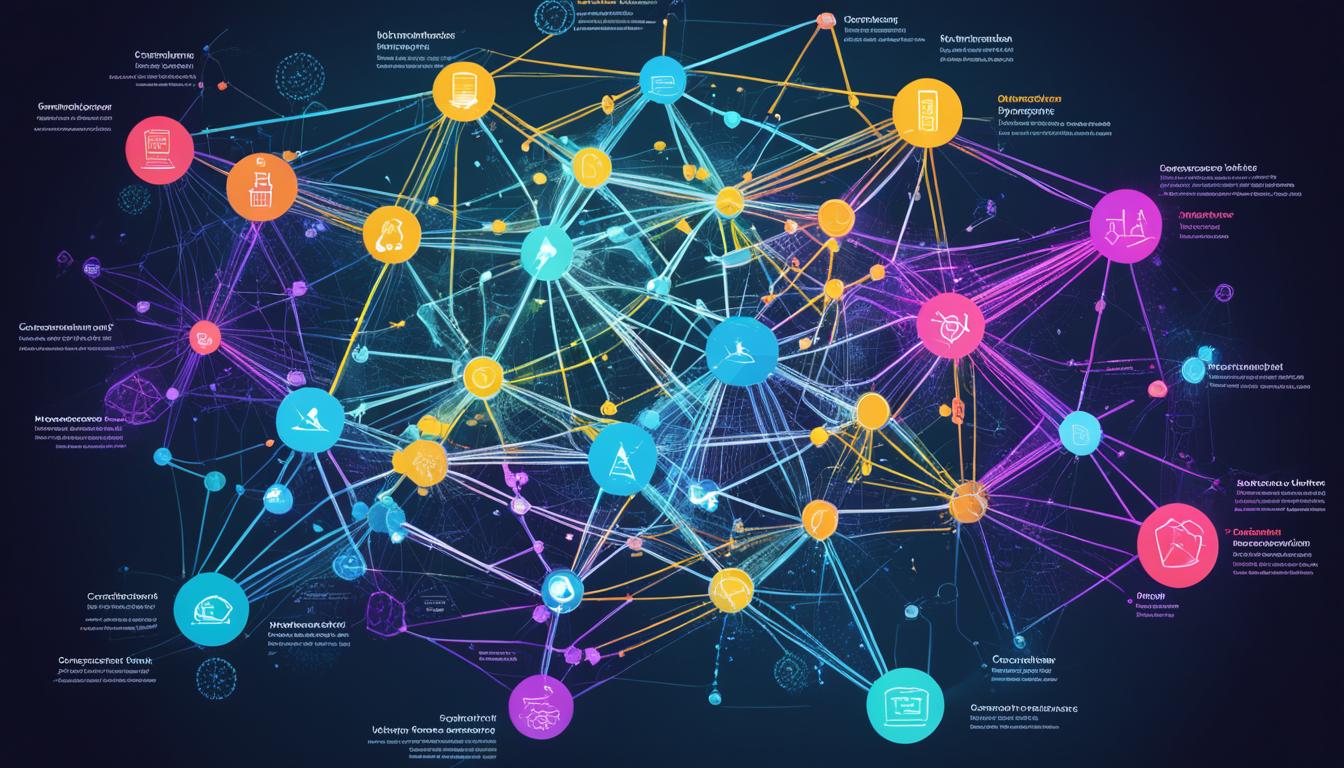
In the modern business landscape, big data has become an indispensable tool for driving decision-making and strategic planning. Organizations today heavily rely on this vast trove of information to adapt to an ever-expanding array of data sources, both internal and external. This reliance extends to a variety of business intelligence tools and data visualization techniques used to harness this data effectively.
With an estimated 2.5 quintillion bytes of data generated daily, big data is undoubtedly pivotal in understanding and developing all aspects of an organization’s goals. However, known for its sheer volume and rapid collection, big data can overwhelm and lead to analysis paralysis if not managed and analyzed objectively. But, when dissected thoughtfully, it can provide the critical insights necessary for strategic advancement, enabling data-driven decision making, predictive analytics, and AI-powered insights.
Key Takeaways
- Leverage big data analytics to drive strategic decision-making and business insights by 2025
- Utilize a range of business intelligence tools and data visualization techniques to harness the power of big data
- Adopt predictive analytics and machine learning models to uncover valuable insights hidden within vast data sets
- Ensure effective data governance frameworks and address data privacy concerns to unlock the full potential of big data
- Stay ahead of the curve by investing in real-time data processing and AI-powered insights for competitive advantage
Understanding the Evolution of Big Data Analytics
The modern business landscape has witnessed a remarkable evolution in the way organizations leverage big data strategies for informed decision-making. In the past, businesses primarily focused on structured data from internal systems, such as financial records and customer databases. However, the rapid proliferation of digital technology has ushered in a new era of unstructured data from a diverse array of sources, including social media, IoT devices, and online transactions.
This transition has been fueled by several key market trends driving big data adoption. The exponential growth of Internet of Things (IoT) devices has generated a vast and continuously expanding pool of data, offering organizations unprecedented opportunities to gain real-time insights and enhance their data-driven decision making. Simultaneously, the increasing reliance on cloud computing has made it easier for businesses to store, process, and analyze this data at scale, enabling them to uncover predictive analytics and AI-powered insights.
As businesses grapple with the sheer volume and complexity of this data, big data analytics has become essential for deriving meaningful insights. Organizations are now leveraging advanced business intelligence tools and data visualization techniques to transcend traditional reporting and unlock the full potential of their data. From machine learning models that identify patterns and predict future trends to real-time data processing for rapid decision-making, the sophistication of analytics tools and techniques continues to evolve, empowering businesses to stay ahead in a rapidly changing landscape.
By embracing this data governance frameworks and harnessing the power of big data, organizations can unlock a competitive edge, driving innovation and growth in the years to come.
Practical Applications of Big Data Across Industries
The proliferation of big data has revolutionized the way businesses operate across diverse sectors. Leveraging
data-driven decision making
, organizations are harnessing the power of
predictive analytics
and
machine learning models
to drive innovation and optimize efficiency.
Transportation and Aviation
In the transportation and aviation industries, big data analytics is being utilized to enhance route optimization, improve passenger experiences, and optimize fleet management. Airlines are using real-time data processing to track flight patterns, weather conditions, and passenger behavior, enabling them to make data-driven decisions that enhance on-time performance and reduce operational costs.
Healthcare and Wearable Technology
The healthcare sector has embraced big data with open arms, leveraging predictive analytics and AI-powered insights to improve patient outcomes and streamline operations. Wearable technology, coupled with data visualization techniques, is empowering individuals to monitor their health more effectively, while healthcare providers are utilizing this data-driven approach to deliver personalized treatment plans.
Banking, Financial Services, and Fraud Detection
In the banking and financial services industry, big data is revolutionizing the way organizations detect and prevent fraud. By applying machine learning models to analyze transaction patterns and customer behavior, financial institutions can quickly identify anomalies and mitigate risk in real-time. Furthermore, business intelligence tools are enabling these organizations to gain deeper insights into customer preferences, leading to more tailored products and services.
Media, Entertainment, and Personalized Content
The media and entertainment industries have leveraged big data to deliver personalized content and enhance customer engagement. Streaming platforms, such as Netflix, utilize data-driven decision making and predictive analytics to recommend content based on user preferences, while social media platforms employ data visualization techniques to optimize ad placement and target specific demographics.

How can I leverage big data analytics for business insights by 2025?
Implementing big data strategies within organizations requires a nuanced approach. First, identifying relevant data sources and integrating them into a cohesive analytics system is crucial. For instance, banks have leveraged big data for fraud detection and customer relationship optimization, analyzing patterns in customer transactions and interactions. Additionally, big data aids in personalized marketing, with companies like Amazon using customer data to tailor marketing strategies, leading to more effective ad placements.
Aligning Big Data Initiatives with Business Objectives
To effectively leverage big data analytics for business insights, it’s essential to align your initiatives with your organization’s overall objectives. This ensures that the data-driven insights you uncover are directly relevant and actionable, driving strategic decision-making and data-driven decision making across the enterprise.
Investing in the Right Tools and Analytical Skills
Maximizing the value of big data requires investing in the right tools and analytical skills. This includes business intelligence tools, data visualization techniques, and machine learning models that can surface predictive analytics and AI-powered insights. Additionally, cultivating a workforce with real-time data processing and data governance frameworks expertise is crucial for deriving meaningful insights from the vast array of big data.
Addressing Data Privacy and Security Concerns
As organizations leverage big data for strategic advantage, they must also address data privacy and security concerns. Establishing robust data governance frameworks and implementing data protection measures are essential to ensure compliance with evolving regulations and maintain the trust of customers and stakeholders.
Conclusion
As we look to the future, the transformative power of big data is set to reach new heights. With advancements in artificial intelligence (AI) and machine learning, the global data sphere is forecasted to swell to an astounding 175 zettabytes by 2025, according to IDC. This exponential growth underscores the mounting volume and complexity of data that businesses must navigate.
To stay ahead in this data-centric future, organizations must take a proactive approach. Investing in scalable data infrastructure and enhancing your workforce’s analytical skills will be crucial. Additionally, adapting to emerging data privacy regulations and maintaining robust data governance frameworks will be vital to your success.
By embracing this holistic approach, your business will be poised to harness the full potential of big data analytics. From deriving deeper insights to driving continuous innovation, leveraging big data will be the key to maintaining a competitive edge in the years to come. With the right strategies and tools in place, you’ll be well-equipped to navigate the data-driven landscape and ensure your organization’s sustained growth and success.
FAQ
How can businesses leverage big data analytics to gain valuable business insights by 2025?
Businesses can leverage big data analytics in several ways to gain valuable insights by 2025:
– Identify relevant data sources and integrate them into a cohesive analytics system
– Align big data initiatives with specific business objectives to derive meaningful insights
– Invest in the right tools and analytical skills to effectively process and analyze large, complex datasets
– Address data privacy and security concerns to ensure responsible and ethical use of big data
What are the key market trends driving the adoption of big data in business?
The adoption of big data in business is driven by several key market trends, including:
– The exponential growth of Internet of Things (IoT) devices, generating vast amounts of unstructured data
– Increasing reliance on cloud computing, enabling the storage and processing of large datasets
– The evolution of big data analytics tools, offering more sophisticated predictive and prescriptive capabilities
How are different industries leveraging big data for growth and innovation?
Big data is being utilized across various industries in unique ways:
– Transportation and aviation: Optimizing operations, logistics, and passenger experiences
– Healthcare and wearable technology: Personalized medicine, disease prevention, and patient monitoring
– Banking and financial services: Fraud detection, customer relationship optimization, and risk management
– Media and entertainment: Personalized content recommendations and targeted advertising
What are the key considerations for implementing effective big data strategies within organizations?
Implementing successful big data strategies requires a multifaceted approach, including:
– Identifying relevant data sources and integrating them into a cohesive analytics system
– Aligning big data initiatives with specific business objectives to drive meaningful insights
– Investing in the right tools and enhancing the analytical skills of the workforce
– Addressing data privacy and security concerns to ensure responsible data management
How will big data continue to evolve and transform businesses by 2025?
The evolution of big data in business will be driven by several key developments by 2025:
– Continued growth in the global data sphere, reaching an estimated 175 zettabytes
– Advancements in AI and machine learning, enabling more sophisticated predictive and prescriptive analytics
– The need for scalable data infrastructure and enhanced data governance frameworks to manage the increasing volume and complexity of data
